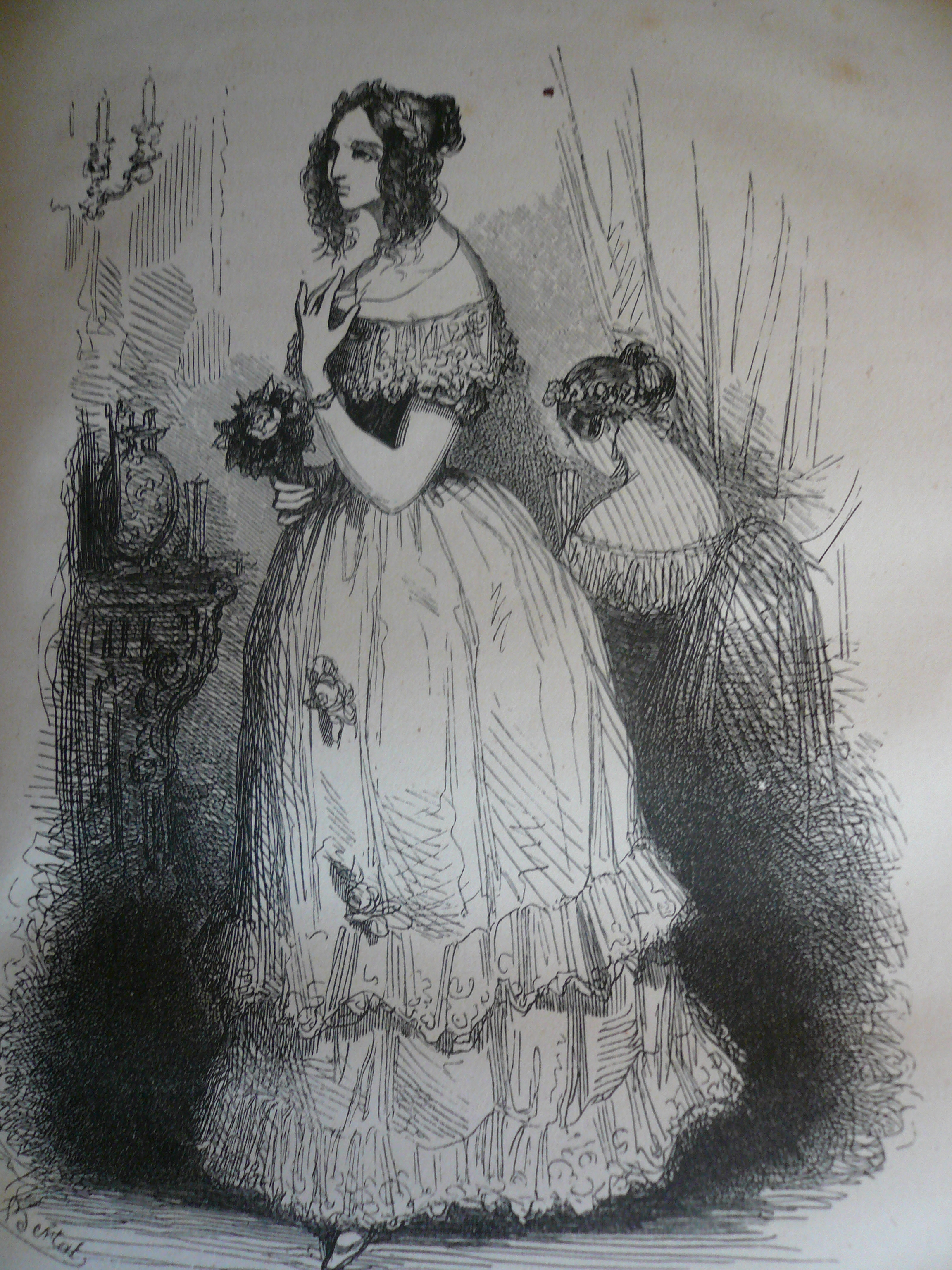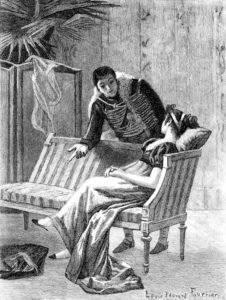
The Thirteen – The Duchess of Langeais
THE HUMAN COMEDY – Honoré de Balzac THE HUMAN COMEDY Scenes from Parisian life HISTOIRE DES TREIZE is a novel with 3 episodes under the titles: Ferragus, la Duchesse de Langeais, La Fille aux yeux d’or.

Duchesse de Langeais
THE DUCHESS OF LANGEAIS Dedicated by Honoré de Balzac to Frantz Listz
Analysis of the work La Duchesse de Langeais is the strangest of these episodes, because Balzac mixes one of the Thirteen’s most extraordinary exploits with a personal settling of scores. Despite the storyteller’s skill, the mix is not right and leaves a rather cloudy impression. The settling of scores relates to a well-known episode in Balzac’s love life, his failure with Henriette de Maillé, Marquise and then Duchesse de Castries. Their friendship had begun in 1832; Balzac had joined her in Switzerland in August of that year, and was due to travel with her to Italy. He had high hopes. The disappointment had been bitter, the anger great, he’d thought himself the plaything of a coquette. This anger had inspired him to write a vengeful account, which he had turned into a Confession du Médecin de campagne ( Confession of the Country Doctor ) that remained in his drawers. La Duchesse de Langeais is based on this disappointment: it’s a literary transposition, already more distant, less direct. This transposition gives rise to an astonishing portrait of a woman whose power and truth come not only from the coquettish maneuvers Balzac describes from his memories, but above all from the reversal he imagines and the heroism he puts into an imaginary denouement. The beauty of the story lies in the absolute, uncompromising character of the revelation of love in a cold woman, suddenly tamed, enslaved, offered prey, but in this very defeat, great in the abdication she makes of her whole life. The set-up that leads to this denouement is absurd, and the psychological construction that brings it about is questionable. Balzac starts with the image of the tease and paints a beautiful portrait of a tease. Only, he draws the conclusion that a tease who refuses a brave artillery colonel is a great criminal who deserves the worst punishment. Balzac doesn’t understand that this haphazard conclusion makes a mockery of the dreadful colonel, who is bellowing with fury at his discomfiture. This reckless claim exposes the storyteller to two disadvantages: on the one hand, a melodramatic and grotesque revenge followed by a maritime expedition that one is entitled to find disproportionate to the event – and on the other, a laborious explanation that looks very much like a “tartine” to shift the blame for this personal misfortune onto an entire political structure. Despite these flaws, the novel has enthusiastic admirers: ” La Duchesse de Langeais is among the most moving stories you can read,” writes Alain in his book. But then we see that Alain was seduced by the cleverness of the tale, the mystery, the flashback, newer in his time than in ours. Jean Giraudoux has turned La Duchesse de Langeais into a beautiful film, a little slow, solemn and unfaithful. But we have to bow to these considerable admirers.
The story During a French expedition to Spain to re-establish the authority of King Ferdinand VII, French general de Montriveau finds the woman he loves hiding in a convent under the name of Sister Thérèse. The reason for this isolation lies in the feelings of these two characters. This story begins in the pomp and grandeur of the aristocratic châteaux and palaces of Paris’s faubourg Saint-Germain. At the beginning of the short-lived life of the Faubourg Saint-Germain during the Restoration, Antoinette de Langeais was, for a time, the most complete type of the nature, both superior and weak, great and small, of the so-called “nobility”. Beautiful and artificial, proudly putting herself above the world, sheltered by her name, this Précieuse, endowed with feelings that she wants to elevate for the World but which, in reality, are only a facade, is a monster of selfishness, cold, calculating and devoid of heart. Born into the Navarreins, a ducal family whose principle since Louis XIV has been not to abdicate its title in its alliances, Antoinette married the eldest son of the Duc de Langeais at the age of 18. In 1818, Monsieur le Duc de Langeais commanded a military division, and the duchess had a position with a princess that allowed her to stay in Paris. Because of their social position, the duke and duchess lived apart, in fact and in their hearts, unbeknownst to the world. This conventional marriage united two contradictory personalities. Their disunion was soon consummated. The Duc de Langeais gave himself over to his boyish activities and pleasures, leaving his wife free to follow in his footsteps. Queen of fashion, she could at ease mock men and their passions, arouse them, collect the tributes that all feminine nature feeds on, and remain mistress of herself. Her life filled exclusively with the ball, with dull amusements, with ephemeral passions born and died in the course of an evening, she sets herself the new challenge of winning Armand’s good feelings and deploying all her coquetries for him, the better to play on this great man’s heart.

The Duchesse de Langeais and General de Montriveau
Monsieur Armand de Montriveau, the only son of General de Montriveau, was soon orphaned. Under Bonaparte’s care, he was placed at the school in Châlons and placed under the protection of the French Republic. After joining the army, his military career took him to the highest ranks. From poor to rich, he regained his title of marquis. Armand falls into the woman’s trap and falls madly in love with her. She’ll use every feminine cruelty and flirtation to refuse him. She suddenly disappears from the world stage, leaving behind a letter that Armand feels very guilty about. Thanks to the “Conspiration des Treize” (Conspiracy of the Thirteen), which includes the Marquis de Ronquerolles and Henri de Marsay, he tracks Antoinette to Spain, where she has taken refuge in a convent. For a proper understanding of this summary, it’s worth pointing out that Antoinette was the widow of the Duc de Langeais, who died in 1823. Claiming he was her brother, Antoinette obtained permission from the monastery’s superior to visit. The two lovers meet again. Antoinette confesses her faults and her secret love for Armand. With the help of his friends, Armand organizes Antoinette’s escape. He arrives only to discover that this beloved woman of 29 years, weakened by privation and the austere life of the convent, consumed by tears and regret, is dead. Geneva, Pré-Lévèque, January 26, 1834

Henry de Marsay
The characters Duchesse Antoinette de Langeais: Antoinette de Navarreins (1794-1823), wife of the Duc de Langeais. According to Félicien Marceau, author of Balzac et son monde – Gallimard, it seems that the Duc de Langeais had a brother who is featured in Le Contrat de mariage. Comte Armand de Montriveau: His family is noble. Armand de Montriveau was orphaned at an early age. Following the death of his father, General de Montriveau, Napoleon placed him under the protection of the French Republic. His military career took him to the upper echelons of the social ladder. He will regain his title of marquis. Maxime de Traille : Count born around 1792. His presumed wife was Cécile Beauvisage, born in 1820. Marquis de Ronquerolles: Born into a noble Burgundian family, the Marquis de Ronquerolles is a politician. His two children died in infancy. He had two sisters, one of whom, Léontine, married General Gaubert and the Comte de Sérizy in succession, while the second married the Marquis du Rouvre, resulting in a daughter who married Laginsky.
1) Source analysis/history: Preface, taken from Volume XII, compiled from the complete text of the Comédie Humaine published by France Loisirs 1985 under the auspices of the Société des Amis d’Honoré de Balzac.
2) Character genealogy source: Félicien Marceau “Balzac et son monde chez Gallimard” (Balzac and his world at Gallimard)
3) Additional notes: Wikipedia universal encyclopedia.
No Comments